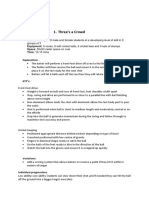Zehra
Zehra
Uploaded by
Elkana Jelai BarbaCopyright:
Available Formats
Zehra
Zehra
Uploaded by
Elkana Jelai BarbaCopyright
Available Formats
Share this document
Did you find this document useful?
Is this content inappropriate?
Copyright:
Available Formats
Zehra
Zehra
Uploaded by
Elkana Jelai BarbaCopyright:
Available Formats
1. What are the 5 basic skills in Volleyball. Explain each.
Bumping- also known as forearm passing, is a crucial volleyball skill for all positions. It's
how you maintain the ball in play and help your team succeed. Passing, contrary to
popular belief, is more about your bottom body than your upper body, and perfecting
your stance is crucial.
Setting- Setting and volleying are two sorts of contact that assist you in positioning your
teammates to attack and slam the ball over the net. Setting, like bumping, is a hand
talent that is unexpectedly reliant on lower body power. You want to volley the ball high
enough so that your teammate has enough time to respond, which requires agility and
good positioning.
Spiking- Few volleyball techniques garner as much attention as an incredible forceful
spike! It's all about power, timing, and precise footwork with this skill. When spiking,
you must also be uniquely adaptable, adjusting to the ball as it is set by your teammate
in a split second. This is why it's critical to pay attention to every detail of the game,
especially when you're in position to score.
Serve- Volleyball would not exist without a serve. The serve, which begins each play,
sets the tone for the entire game. What distinguishes serving from other volleyball
maneuvers is that it is the only time throughout the game when you begin with
complete control and possession of the ball, which is why so many servers are
preoccupied with strategy and perfection.
Blocking- Defense is critical to a good match, and it all boils down to blocking. Blockers
have a few exceptional skills of their own, including the ability to make quick decisions.
Blockers can also excel by perfecting their footwork and being able to step, shuffle, and
crossover as needed. Blockers must be able to correctly time their jumps in order to
block effectively.
2. Please give 5 different terms used in Volleyball. Explain each.
Outside Hitter- The "outside hitter" or "left-side hitter" is the player who plays on the
left side of the court in the front and back-row. Their main job is to attack and pass.
Typically, this player is best at terminating the ball and will receive 60 percent or more
of the sets in a match. They should be trained in hitting in less-than-perfect situations as
bad passes should be set to this player to attack.
Middle Blocker- The "middle blocker" is the player who plays in the middle of the court
in the front row. This player's main job is to attack and block. Typically, this player hits
well in medium to perfect situations and can move well along the net, as well as get
their hands over onto the opponent's side of the net while blocking. This player is
frequently replaced by the libero in the back-row, but this decision should be based on
the abilities of the players on the team.
Left-Back- The back-row area on the left is referred to as "left-back," and a player is said
to play "left-back" on defense or serve receive. The back-row area in the middle is
referred to as "middle-back," and a player is said to play "middle-back" on defense or
serve receive. Finally, "right-back" refers to the back-row location on the right, and a
player can be said to play "right-back" on defense or serve receive.
Left-Front- The front-row area on the left is called “left-front." A player can be said to
play “left-front” on defense or offense.
Over Pass- The pass by the team receiving the serve that is sent immediately back over
the net to the serving team on accident is called an “overpass.
3. As a students what do you think is the benefit you can get in knowing and playing this kind of
sport?
To begin with, it's a fun method to burn calories. As a student, knowing and playing
volleyball can help me develop my muscle strength and tone. Volleyball requires
routines that build the upper body, arms, shoulders, thighs, abdominals, and lower legs.
Volleyball also helps with hand-eye coordination, reflexes, and balance. Last but not
least, volleyball is a terrific social activity that teaches teamwork and communication.
You might also like
- The Subtle Art of Not Giving a F*ck: A Counterintuitive Approach to Living a Good LifeFrom EverandThe Subtle Art of Not Giving a F*ck: A Counterintuitive Approach to Living a Good LifeRating: 4 out of 5 stars4/5 (6016)
- The Gifts of Imperfection: Let Go of Who You Think You're Supposed to Be and Embrace Who You AreFrom EverandThe Gifts of Imperfection: Let Go of Who You Think You're Supposed to Be and Embrace Who You AreRating: 4 out of 5 stars4/5 (1113)
- Never Split the Difference: Negotiating As If Your Life Depended On ItFrom EverandNever Split the Difference: Negotiating As If Your Life Depended On ItRating: 4.5 out of 5 stars4.5/5 (909)
- Grit: The Power of Passion and PerseveranceFrom EverandGrit: The Power of Passion and PerseveranceRating: 4 out of 5 stars4/5 (619)
- Hidden Figures: The American Dream and the Untold Story of the Black Women Mathematicians Who Helped Win the Space RaceFrom EverandHidden Figures: The American Dream and the Untold Story of the Black Women Mathematicians Who Helped Win the Space RaceRating: 4 out of 5 stars4/5 (937)
- Shoe Dog: A Memoir by the Creator of NikeFrom EverandShoe Dog: A Memoir by the Creator of NikeRating: 4.5 out of 5 stars4.5/5 (546)
- The Hard Thing About Hard Things: Building a Business When There Are No Easy AnswersFrom EverandThe Hard Thing About Hard Things: Building a Business When There Are No Easy AnswersRating: 4.5 out of 5 stars4.5/5 (358)
- Her Body and Other Parties: StoriesFrom EverandHer Body and Other Parties: StoriesRating: 4 out of 5 stars4/5 (831)
- Elon Musk: Tesla, SpaceX, and the Quest for a Fantastic FutureFrom EverandElon Musk: Tesla, SpaceX, and the Quest for a Fantastic FutureRating: 4.5 out of 5 stars4.5/5 (479)
- The Emperor of All Maladies: A Biography of CancerFrom EverandThe Emperor of All Maladies: A Biography of CancerRating: 4.5 out of 5 stars4.5/5 (275)
- The Little Book of Hygge: Danish Secrets to Happy LivingFrom EverandThe Little Book of Hygge: Danish Secrets to Happy LivingRating: 3.5 out of 5 stars3.5/5 (434)
- The World Is Flat 3.0: A Brief History of the Twenty-first CenturyFrom EverandThe World Is Flat 3.0: A Brief History of the Twenty-first CenturyRating: 3.5 out of 5 stars3.5/5 (2281)
- The Yellow House: A Memoir (2019 National Book Award Winner)From EverandThe Yellow House: A Memoir (2019 National Book Award Winner)Rating: 4 out of 5 stars4/5 (99)
- The Sympathizer: A Novel (Pulitzer Prize for Fiction)From EverandThe Sympathizer: A Novel (Pulitzer Prize for Fiction)Rating: 4.5 out of 5 stars4.5/5 (125)
- Devil in the Grove: Thurgood Marshall, the Groveland Boys, and the Dawn of a New AmericaFrom EverandDevil in the Grove: Thurgood Marshall, the Groveland Boys, and the Dawn of a New AmericaRating: 4.5 out of 5 stars4.5/5 (273)
- A Heartbreaking Work Of Staggering Genius: A Memoir Based on a True StoryFrom EverandA Heartbreaking Work Of Staggering Genius: A Memoir Based on a True StoryRating: 3.5 out of 5 stars3.5/5 (232)
- Team of Rivals: The Political Genius of Abraham LincolnFrom EverandTeam of Rivals: The Political Genius of Abraham LincolnRating: 4.5 out of 5 stars4.5/5 (235)
- 7 Principles of ExerciseDocument3 pages7 Principles of ExerciseJo Marchianne PigarNo ratings yet
- On Fire: The (Burning) Case for a Green New DealFrom EverandOn Fire: The (Burning) Case for a Green New DealRating: 4 out of 5 stars4/5 (75)
- BadmintonDocument38 pagesBadmintonSumukh GoutamNo ratings yet
- The Unwinding: An Inner History of the New AmericaFrom EverandThe Unwinding: An Inner History of the New AmericaRating: 4 out of 5 stars4/5 (45)
- Training Tuesdays Mega SpreadsheetDocument18 pagesTraining Tuesdays Mega Spreadsheetmtloot100% (1)
- Team Taylor ChallengesDocument2 pagesTeam Taylor ChallengesV BNo ratings yet
- Test15hk2l2 11Document4 pagesTest15hk2l2 11Anonymous IDqa6WcJNo ratings yet
- Dhyan ChandDocument4 pagesDhyan ChandNithin KiranNo ratings yet
- Educational Presentation of Kumite Rules Version7 1Document152 pagesEducational Presentation of Kumite Rules Version7 1All4UyenNo ratings yet
- 2017 Record and Fact Book (8.7.17)Document851 pages2017 Record and Fact Book (8.7.17)Sharona FabNo ratings yet
- Sample MesosDocument8 pagesSample MesoschristineNo ratings yet
- The Mini-Max MethodDocument20 pagesThe Mini-Max MethodAlberto Sarly CoutinhoNo ratings yet
- Log Book Coaching Fumaga Futsal School Season 1Document5 pagesLog Book Coaching Fumaga Futsal School Season 1sarnubiNo ratings yet
- BMM - Awfa Womens DrawDocument1 pageBMM - Awfa Womens DrawBeau GreenwayNo ratings yet
- Question Answer BA 2Document8 pagesQuestion Answer BA 2Anonymous v5QjDW2eHxNo ratings yet
- WHS ScholarshipsDocument18 pagesWHS ScholarshipsReporterJennaNo ratings yet
- Javi Galán FIFA Mobile 22 FIFARenderZDocument1 pageJavi Galán FIFA Mobile 22 FIFARenderZkyle27dsouzaNo ratings yet
- MIF - 10 Weeks Fat Loss ProgramDocument7 pagesMIF - 10 Weeks Fat Loss ProgramNiraj Tripathi100% (1)
- Statis Pro Rules 5-2013Document8 pagesStatis Pro Rules 5-2013peppylepepper100% (1)
- Legends of Sport - July 2016 PDFDocument150 pagesLegends of Sport - July 2016 PDFebt555No ratings yet
- Kobe EpDocument5 pagesKobe Epapi-510880199No ratings yet
- Sepak Takraw: Importance of SepaktakrawDocument9 pagesSepak Takraw: Importance of SepaktakrawRicMartinNo ratings yet
- Batting SkillsDocument8 pagesBatting Skillsapi-453728680No ratings yet
- ScheduleDocument2 pagesScheduleColinNo ratings yet
- 2012 Cleveland Browns Media Guide (292p)Document292 pages2012 Cleveland Browns Media Guide (292p)pauldNo ratings yet
- Physical Education (Code No. 048)Document38 pagesPhysical Education (Code No. 048)Sanjay Kumar MishraNo ratings yet
- Elyse Borys: SkillsDocument2 pagesElyse Borys: Skillsapi-557729377No ratings yet
- PHTCC Dropin Schedule 0Document1 pagePHTCC Dropin Schedule 0ruben GalarzaNo ratings yet
- Sports LeagueDocument6 pagesSports LeagueAndrei GiscaNo ratings yet
- Saratoga All StarsDocument1 pageSaratoga All StarsThe Saratogian and Troy RecordNo ratings yet
- The Badgers Windy City Inaugural Invite ScheduleDocument1 pageThe Badgers Windy City Inaugural Invite ScheduleTony JonesNo ratings yet





































































